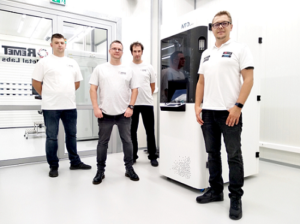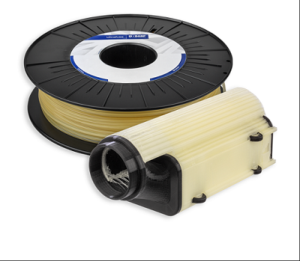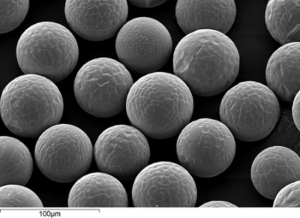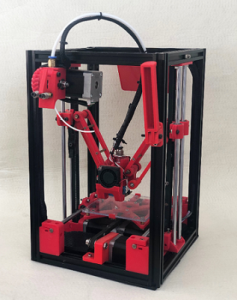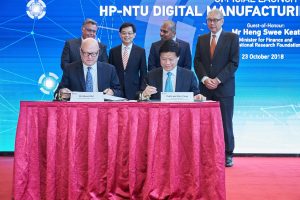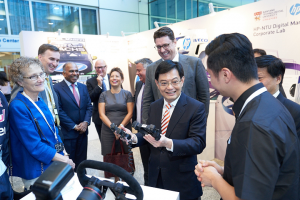We’re finishing the week out with some more formnext news for 3D Printing News Briefs: Poly-Shape presented a metal 3D printed Francis Turbine at the event. Moving on, Etihad Engineering opened a 3D printing lab for aircraft parts with EOS and BigRep, and Y Soft launched an online collection of 3D lessons for educators.
Poly-Shape’s 3D Printed Francis Turbine
 At formnext 2019 last week, French company Poly-Shape presented something rather unique: a 72 kg Francis Turbine made with its Directed Energy Deposition-powder (DED-P) metal 3D printing technology. Turbine components are often used in the aerospace and energy industries, and DED-P printing can be used to fabricate the raw part, with its complex geometry, in less than 3 days; in fact, the Francis Turbine was printed in just 55 hours.
At formnext 2019 last week, French company Poly-Shape presented something rather unique: a 72 kg Francis Turbine made with its Directed Energy Deposition-powder (DED-P) metal 3D printing technology. Turbine components are often used in the aerospace and energy industries, and DED-P printing can be used to fabricate the raw part, with its complex geometry, in less than 3 days; in fact, the Francis Turbine was printed in just 55 hours.
“The DED-P process is operated within a 5-axis CNC machine thanks to a material depositing system,” a Poly-Shape press release stated.
“By minimizing the needed allowance (typically < 1,5 mm), the part machining is reduced to finishing operation. In case of hard to access areas, the DED and the machining production can be sequenced such as the tool accessibility would be released.”
Etihad’s 3D Printing Lab for Aircraft Parts
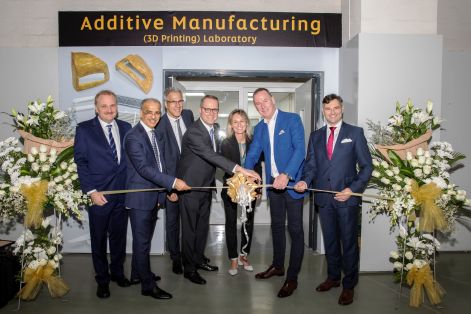
Bernhard Randerath, VP Design, Engineering & Innovation, Etihad Engineering; Abdul Khaliq Saeed, CEO, Etihad Engineering; Markus Glasser, SVP EOS; H.E. Ernst Peter Fischer, German Ambassador to the UAE; Marie Langer, CEO EOS; Tony Douglas, Group CEO Etihad Aviation Group; Martin Black, CEO BigRep.
Etihad Engineering, a division of the Etihad Aviation Group, partnered with EOS and BigRep to open a 3D printing lab. It’s one of the first airline MROs in the Middle East that’s received approval from the European Aviation Safety Agency (EASA) for designing, producing, and certifying cabin parts made with powder bed fusion technology, two years after receiving approval for filament 3D printing. The laboratory is located at the Etihad Engineering facility, adjacent to Abu Dhabi International Airport, and houses two industrial 3D printers – the EOS P 396 and the BigRep ONE. It was opened officially in a ceremony last week, and in recognition of the relationships between Etihad, EOS, and BigRep, was attended by His Excellency Ernst Peter Fischer, German Ambassador to the UAE.
“The launch of the new facility is in line with Etihad Engineering’s position as a leading global player in aircraft engineering as well as a pioneer in innovation and technology,” said Bernhard Randerath, VP Design, Engineering and Innovation for Etihad Engineering. “We are extremely proud to collaborate with EOS and BigRep to expand our capability and support the UAE’s strategy to increase production technology and cement its position as a global aerospace hub.”
Y Soft Launches be3D Academy for Educators
 The Y Soft Corporation has launched its be3D Academy, available as part of its YSoft be3D eDee 3D printing solution for education. There are many benefits to using classroom 3D printing as a tool for learning, and adoption in schools is growing fast, but developing lesson plans that incorporate the technology can be difficult, due to lack of knowledge or access. The company’s new online collection of teacher-tested 3D lesson plans in STEAM subjects make it easy for educators to teach in 3D. The be3D Academy lesson plans provide tools like student worksheets, presentations, video tutorials, and 3D model files, all of which can be made on the YSoft be3D eDee printer with its certified filaments.
The Y Soft Corporation has launched its be3D Academy, available as part of its YSoft be3D eDee 3D printing solution for education. There are many benefits to using classroom 3D printing as a tool for learning, and adoption in schools is growing fast, but developing lesson plans that incorporate the technology can be difficult, due to lack of knowledge or access. The company’s new online collection of teacher-tested 3D lesson plans in STEAM subjects make it easy for educators to teach in 3D. The be3D Academy lesson plans provide tools like student worksheets, presentations, video tutorials, and 3D model files, all of which can be made on the YSoft be3D eDee printer with its certified filaments.
“3D printing is particularly valuable in the classroom to convey complex subjects. When students can touch and adjust physical objects they have created, understanding increases. Comprehension of STEAM subjects can be difficult, and be3D Academy’s lessons make concepts interesting and fun. be3D Academy lesson plans range from creating castles to understanding geometric shapes and volumes to creating a Da Vinci bridge as a science learning project,” said Elke Heiss, the Y Soft Chief Marketing Officer.
The be3D Academy is open to all educators looking to add 3D printing to their classrooms.
Discuss these stories and other 3D printing topics at 3DPrintBoard.com or share your thoughts in the Facebook comments below.
The post 3D Printing News Briefs: November 25, 2019 appeared first on 3DPrint.com | The Voice of 3D Printing / Additive Manufacturing.



